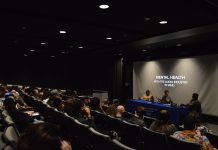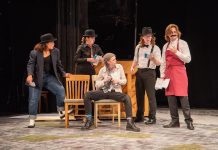
Artistic Director Rich O’Donnell calls AQurld Waves “an invitation to a new reality.”
Attendees experienced AQurld Waves on Aug. 31 at St. Louis’s first underwater concert, held at the Webster University pool. Underwater instruments, lights, videos, a live-music mix and Tai Chi players were all part of the improvised experience.
O’Donnell and his wife are two of the four founders of the HEARding Cats Collective, a non-profit organization producing artistic events in St. Louis. For O’Donnell, AQurld Waves is the product of a concept he has thought about for 15 years. He had the opportunity to bring it to life after receiving a grant from Regional Arts Commission’s Innovation Fund.
O’Donnell spent a lot of time listening to aquatic animals, which he called a wonderful experience. He said he feels very close to them. He wanted to develop instruments that could be played underwater and emulate the flexibility and characteristics of aquatic animal sounds, rather than human-invented instruments.
“For me, a musical instrument is something that can be an extension of your body, of your mind, and so they had to have that characteristic,” O’Donnell said.
O’Donnell has a lifelong history of building instruments and he said it’s not unusual for him to create sounds rather than purchase them. Instruments used in the performance included:
a barbecue grill to get ‘pluck’ sounds.
old cookie sheets without the non-stick coating to transfer vibrations through the water.
stainless-steel bowls, pot lids.
a wok—a frying pan that is shaped like a bowl.
O’Donnell used cello and violin bows on the objects to produce low ‘growl’ sounds, similar to those a whale makes.
It took a lot of time to produce the instruments used in AQurld Waves. O’Donnell spent more than 100 hours over a period of four months experimenting.
“It’s not failing. It’s experimenting and finding out why it doesn’t work,” O’Donnell said. “So I look at failure as something that gives you empowerment, because, by the time I was through, I’d learned something that’s useful and I know something that I didn’t know before.”
O’Donnell is the director of electronic music studio at Washington University.
“I think in the way a synthesis person does. You construct a sound from modules. With the constructing you have to analyze how it’s made, and I do the same thing with percussion instruments,” O’Donnell said.
O’Donnell would test his creations using a big bucket of water in his backyard. He stuck an underwater microphone in the bucket and listened through headphones so he could hear how it sounded underwater. When there were too many instruments to fit in the bucket, he took them to his friend Sue Shepard’s pool to test the sounds. Shepard, who designed costumes, passed away in July. AQurld Waves was dedicated to her.
AQurld Waves consisted of three acts running roughly 20 minutes each and was entirely improvised. One hundred fifty people were at the first performance, while around 160 people couldn’t get in and waited in line outside. The performance wasn’t rehearsed, but there were three test runs at Webster’s pool to tweak and experiment with sound, video, speaker placement and lights.
A lightning storm delayed the performance for roughly an hour and 15 minutes after the first act, but most of the audience waited out the storm in the foyer area outside the pool.
The video projected on the screen was under and above water footage of the Tai Chi performers, filmed by Rachel Cosic. It included lights by Bryan Erdmann. This footage was then passed to Van McElwee, professor of electronic and photographic media at Webster. McElwee manipulated the raw footage to create artful, abstract video files. Finally, Zlatko Cosic mixed them together and digitally processed them in real time.
President of the HEARding Cats Collective Mike Murphy, along with Kevin Harris performed on analog synthesizers. Percussionist, Ted Rubright performed alongside O’Donnell as well.
Olivia Murphy, a video production major at Webster and daughter of Mike Murphy, ran the light board at the show.
“I was basically just controlling what colors showed up around the room and kind of made them match the projections,” Olivia said.
O’Donnell’s wife Anna Lum, LeRoy Alsup and Nicholas Alsup performed Tai Chi in the water during the event.
“Tai Chi is something that you do on land, but you want to mimic as if you’re in water, something we can do in water very easy,” Nicholas Alsup said. “It’s smooth moving, graceful and it’s effortless in water, but on land it takes a lot of control and concentration.”
Andrew Coppage and Courtney Fuller learned of the event from Nicholas Alsup. The two were in the water during the performance and said they were surprised to be able to float with the performers. They said hearing the sounds above the water was much different than hearing the sounds below.
Fuller described hearing “animal noises” under the water that she didn’t hear above.
“The gritty sounds smooth out when you go underwater, it was pretty cool,” Coppage said.
O’Donnell’s step-daughter, Debbie Lum, a professional film maker, flew in from San Francisco to capture sights and sounds of AQurld Waves for a documentary.
Rich O’Donnell was pleased overall with the event and is looking at the possibility of doing another show at Webster.
“It seemed to be successful people seemed to appreciate it and get the idea of a ‘theater of the senses,’” O’Donnell said. “The audience was very quiet and meditative, and the feedback we got, they really experienced the magic of floating in the water. Seeing the beautiful videos, seeing the images moving of the bodies of the swimmers and floaters. Everybody seemed to get it.”



